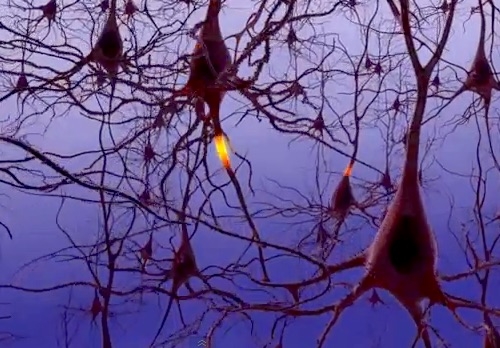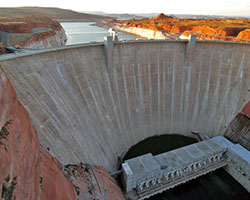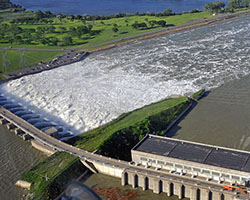show/hide words to know
ATP: adenosine triphosphate. ATP is the energy-carrying molecule of all cells......more
Gradient: a slow or gradual change from one thing to another; a slope or hill.
Ion: an atom or molecule that does not have the same number of electrons as it has protons. This gives the atom or molecule a negative or positive charge... more
Potential energy: energy that an object or molecule has due to its position or structure.
Proton: the part of a molecule that has a positive electric charge; a hydrogen ion that has lost its electron (written as H+).
Transporter: a protein found in the cell membrane that helps control what can enter or exit a cell.
Proton Pumps
If we think of a cell membrane as a dam, we can get a better idea of how the transporters in membranes work. As water builds up on one side of the dam, the concentration gradient is high and has lots of potential energy. If water is let through a spillway or floodgate, it can spin a turbine and create energy.
In the same way, cell membranes keep the concentration gradient of hydrogen high. When a hydrogen ion passes down the concentration gradient through a transporter, it makes that potential energy available. This energy can be used to take a molecule from inside the cell and move it out or can help make ATP in a specialized enzyme.
However, hydrogen ions can also be moved the other way, toward areas of high concentration. This is how concentration gradients are maintained. In the dam, this is like when pumps are used to keep the water level in a reservoir behind the dam high. To move water up the concentration gradient can take a lot of energy. But when that water level (or concentration gradient) is kept high, more energy is stored that can be used for other things.
Pushing Hydrogen
In cells, it is very similar. Proton pumps are a special kind of transporter that push hydrogen ions from areas of low concentration to areas with high concentration. Ions moving down a gradient release energy, but when they move up a gradient, it takes energy. Diffusion can then use this gradient to capture energy again, as the ions move downhill.
In a cell, using energy to move ions uphill when there are already lots of ions there seems a bit odd. Yet this work gives many benefits to the organisms, including plants. If plants did not do this, there would eventually be no more concentration gradient to release energy, and the plant would die. Plants can also strap a sugar molecule to a hydrogen ion to be carried across a membrane. So, when concentrations of hydrogen ions are high, the plant can move more sugar into plant tissues.
So far, we have hydrogen ions moving downhill through transporters and releasing energy. We also have these ions moving uphill, into areas of higher concentration, using a proton pump. Pumping against a gradient can be difficult, so the job of proton pumps is hard work. There is one pump that isn't as strong, and so acts a little out of the ordinary. It is called the Proton Pyrophosphatase Pump.
View Citation
Bibliographic details:
- Article: Proton Pump Particularities
- Author(s): Joshua Haussler, Karla Moeller
- Publisher: Arizona State University School of Life Sciences Ask A Biologist
- Site name: ASU - Ask A Biologist
- Date published: December 19, 2015
- Date accessed: April 17, 2024
- Link: https://askabiologist.asu.edu/proton-pump-particularities
APA Style
Joshua Haussler, Karla Moeller. (2015, December 19). Proton Pump Particularities. ASU - Ask A Biologist. Retrieved April 17, 2024 from https://askabiologist.asu.edu/proton-pump-particularities
Chicago Manual of Style
Joshua Haussler, Karla Moeller. "Proton Pump Particularities". ASU - Ask A Biologist. 19 December, 2015. https://askabiologist.asu.edu/proton-pump-particularities
Joshua Haussler, Karla Moeller. "Proton Pump Particularities". ASU - Ask A Biologist. 19 Dec 2015. ASU - Ask A Biologist, Web. 17 Apr 2024. https://askabiologist.asu.edu/proton-pump-particularities
MLA 2017 Style

All organisms depend on proton pumps, whether to move sugars to plant roots or send signals in the human brain. This illustration shows neural cells sending signals.
Be Part of
Ask A Biologist
By volunteering, or simply sending us feedback on the site. Scientists, teachers, writers, illustrators, and translators are all important to the program. If you are interested in helping with the website we have a Volunteers page to get the process started.









